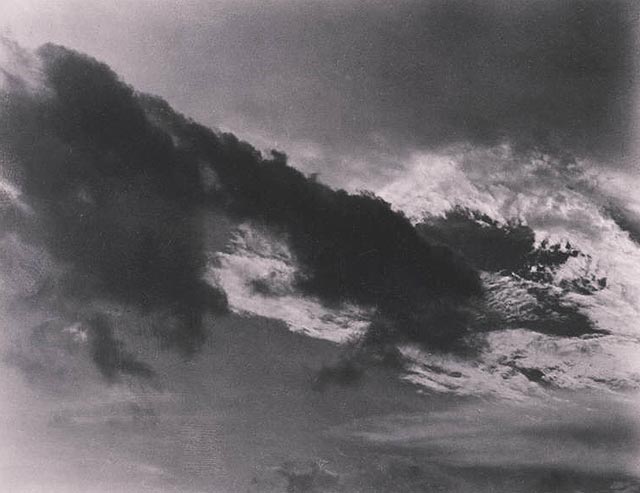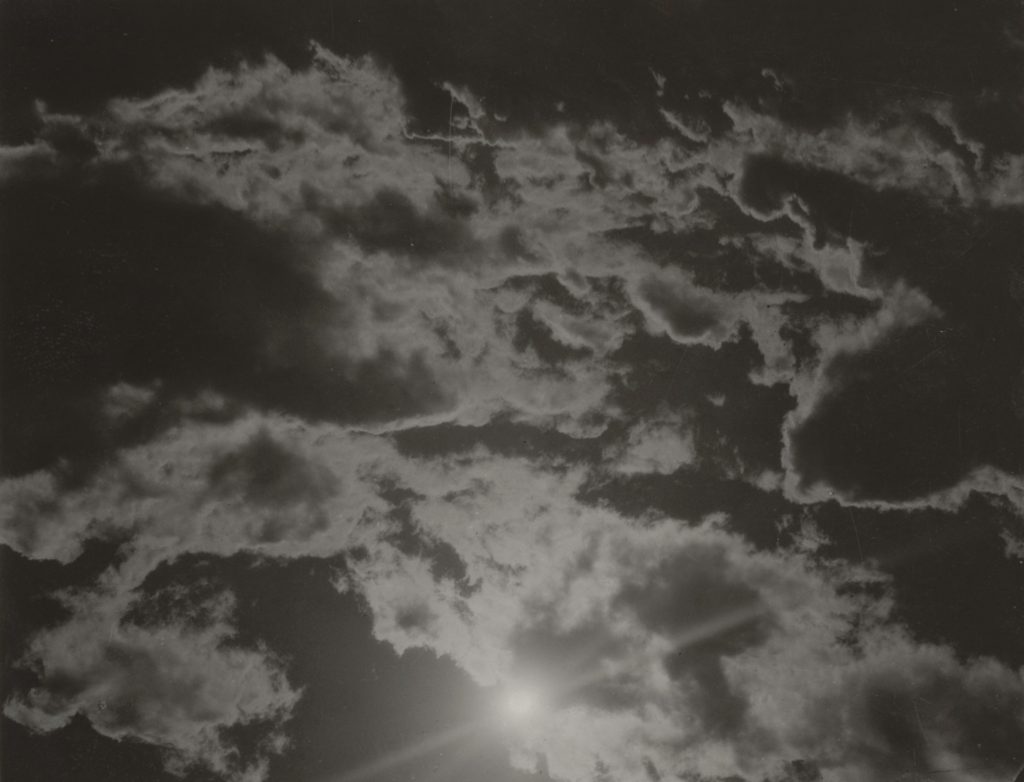
Cloudscape photography is photography of clouds or sky. An early cloudscape photographer, Belgian photographer Léonard Misonne (1870–1943), was noted for his black and white photographs of heavy skies and dark clouds. In the early to middle 20th century, American photographer Alfred Stieglitz (1864–1946) created a series of photographs of clouds, called “equivalents” (1925–1931). According to an essay on the series at the Phillips Collection website, “A symbolist aesthetic underlies these images, which became increasingly abstract equivalents of his own experiences, thoughts, and emotions”. More recently, photographers such as Ralph Steiner, Robert Davies and Tzeli Hadjidimitriou have been noted for producing such images.
Equivalents
In the summer of 1922, Alfred Stieglitz began to take photographs of clouds, tilting his hand camera towards the sky to produce dizzying and abstract images of their ethereal forms. In an article the following year, Stieglitz maintained that these works were a culmination of everything he had learned about photography in the previous forty years:
“THROUGH CLOUDS I WANTED TO PUT DOWN MY PHILOSOPHY OF LIFE—TO SHOW THAT MY PHOTOGRAPHS WERE NOT DUE TO SUBJECT MATTER—NOT TO SPECIAL TREES, OR FACES, OR INTERIORS, TO SPECIAL PRIVILEGES, CLOUDS WERE THERE FOR EVERYONE—NO TAX AS YET ON THEM—FREE.”
Over the next eight years, he made some 350 cloud studies, largely produced as contact prints on gelatin silver postcard stock. Stieglitz called these photographs Equivalents. More than describing the visible surfaces of things, the works could express pure emotion, paralleling the artist’s own inner state. Stieglitz, along with many of the artists of his circle, argued that visual art could assume the same nonrepresentational, emotionally evocative qualities as music. Indeed, music was an inspiration for the Equivalents, and this is reflected in the early titles he gave them: Music: A Sequence of Ten Cloud Photographs (1922) and Songs of the Sky (1923). Stieglitz did not limit himself to clouds, or allusions to music, in these photographs: one notable work, Spiritual America, shows a close-up of the nether regions of a harnessed gelding (a castrated male horse), the image serving as a metaphor for the artist’s impression of a diminished American culture in the same way that his depictions of clouds represented his emotions. Stieglitz often presented the Equivalents in series or sets, recombining different groupings of prints for exhibition.



The Cloudman
The “Cloudman“, Dr. John A. Day, is a professor emeritis from Linfield College, in Oregon, USA, who taught meteorology for over forty years and who has a great passion for sharing the wonder of clouds. Now in his nineties, he continues to write, teach, and inspire people of all ages, around the world. His photography and writings are found in international publications and museums, and are used by artists, musicians, teachers, and many other cloud lovers. In 1962 he was granted a Faculty Fellowship from the National Science Foundation to study Cloud Physics at Imperial College of Science and Technology in London, England. In 1971 he returned to England, this time on sabbatical leave, for intensive study of the History of Cloud Classification, focusing on the work of Luke Howard, England’s first meteorologist. Day’s interest in clouds was first of a technical nature, learning to forecast their appearance and development. Studies of clouds in the ‘50s, ‘60s, and ‘70s were directed toward gaining a fuller understanding of the physical causes that led to the formation of particular cloud types. In this period he started photographing clouds which led to an extensive collection of photographs. In later years his focus of interest has shifted form technical to artistic, and through the medium of photography, he attempts day by day to capture the beauty and majesty seen in the cloud forms that grace the sky. His photographs are rich in colour and greatly differ from the works of Alfred Stieglitz’.

MANY SKIES ARE SIMPLY BEAUTIFUL TO BEHOLD. THERE IS NO OTHER WAY TO SAY IT. SHEER BEAUTY! THE COMBINATION OF FORM, POSITION, GRADATIONS OF LIGHT AND SHADOW, AND EVEN COLOR IN THE LATE EVENING AND EARLY MORNING HOURS IS PLEASING TO THE EYE, AND STIRS AN INNER SENSE THAT CAUSES ONE TO BREATHE AN INAUDIBLE, “AHH, THE GREAT ARTIST AT WORK!”


